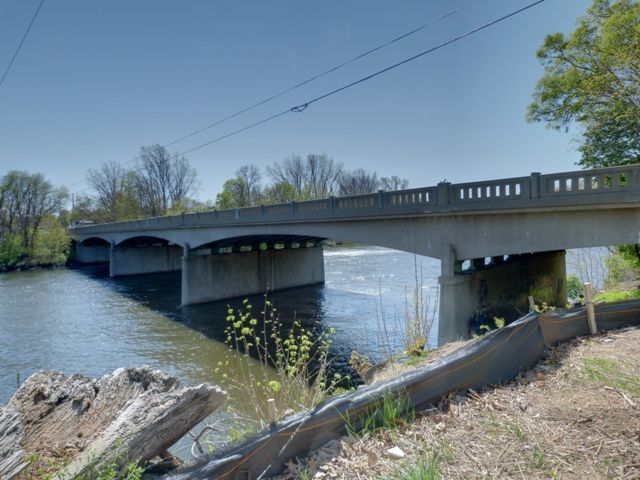We Recommend:
Bach Steel - Experts at historic truss bridge restoration.
BridgeHunter.com Phase 1 is released to the public! - Visit Now
Nappanee Street Bridge
Elkhart County Bridge 376

Primary Photographer(s): Nathan Holth
Bridge Documented: March 4, 2012 and April 8, 2012
Elkhart: Elkhart County, Indiana: United States
Not Available or Not Applicable
101.4 Feet (30.9 Meters)
453.0 Feet (138.1 Meters)
54 Feet (16.46 Meters)
5 Main Span(s)
5165

View Information About HSR Ratings
Bridge Documentation
View Archived National Bridge Inventory Report - Has Additional Details and Evaluation
This bridge is an attractive example and large example of a curved t-beam. Its curved beams offer a simple, but graceful aesthetic. Special decorative posts mounted on the piers beside the bearings obscure the view of the metal bearings for aesthetic purposes. The original railings on the bridge are an attractive balustrade design with attractive stylized wing-like shapes at the ends.
This bridge is to be rehabilitated. It is outstanding that preservation has been chosen for this bridge, rather than likely more costly demolition and replacement. However, in the interest of inspiring improvement in future preservation projects, a critical commentary on one aspect of the rehabilitation is needed. The one disappointment in the project is that the railings are to be removed and replaced. The replacement railings will be a standard design (sometimes called Texas rail) that just happens to be somewhat similar in a general sense to this original railing, however it is not the same and the similarities are merely coincidence. The design is a standard that began in Texas and is now used in many states as a quick way to make railings on both new and old bridges "look historic." This railing is a fine solution in some cases, such as where the original railings on a historic bridge are already lost and the original railing design plans are not available. However, on this bridge, where the original railings remain, it would have been nicer to see the original railing either left in place (it appeared to be in good condition with no major spalling) or replicated. If the original railings were left in place, vehicular railing could have been added between the sidewalk and roadway to meet current collision safety needs. If replicated, minor changes to the design to increase the reinforcing and perhaps the railing height could have been made to meet current safety codes, while still retaining the original shape and appearance of the original railing. Both above described techniques have been employed elsewhere successfully in preservation work. In Michigan, the Mitchell Street Bridge will have its original railings removed and replaced. The replacement railings have been designed as exact replicas with one exception that the concrete on the bottom has been designed as taller. This increases the height of the railing so it meets current safety code, but the dimensions and appearance of the balustrade part of the railing will be identical to the original railing. Such a solution may require more engineering effort, however that is what engineers are paid to do. It comes accross as lazy to simply use a standard design rather than taking the time to design a railing solution that best suits the historic bridge.
![]()
Photo Galleries and Videos: Nappanee Street Bridge
Bridge Photo-Documentation
Original / Full Size PhotosA collection of overview and detail photos. This gallery offers photos in the highest available resolution and file size in a touch-friendly popup viewer.
Alternatively, Browse Without Using Viewer
![]()
Bridge Photo-Documentation
Mobile Optimized PhotosA collection of overview and detail photos. This gallery features data-friendly, fast-loading photos in a touch-friendly popup viewer.
Alternatively, Browse Without Using Viewer
![]()
Maps and Links: Nappanee Street Bridge
Coordinates (Latitude, Longitude):
Search For Additional Bridge Listings:
Bridgehunter.com: View listed bridges within 0.5 miles (0.8 kilometers) of this bridge.
Bridgehunter.com: View listed bridges within 10 miles (16 kilometers) of this bridge.
Additional Maps:
Google Streetview (If Available)
GeoHack (Additional Links and Coordinates)
Apple Maps (Via DuckDuckGo Search)
Apple Maps (Apple devices only)
Android: Open Location In Your Map or GPS App
Flickr Gallery (Find Nearby Photos)
Wikimedia Commons (Find Nearby Photos)
Directions Via Sygic For Android
Directions Via Sygic For iOS and Android Dolphin Browser
USGS National Map (United States Only)
Historical USGS Topo Maps (United States Only)
Historic Aerials (United States Only)
CalTopo Maps (United States Only)


